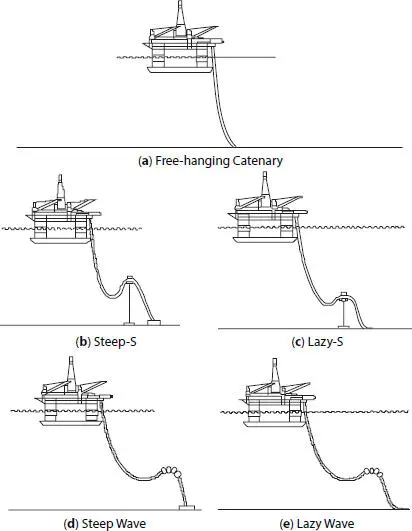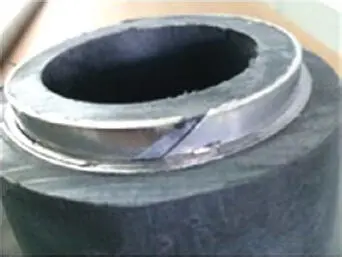
Figure 1.1 Employment of flexible pipelines as risers.
1.3 Flexible Pipeline Geometry
Even if flexible pipelines have many applications, the common factor is to provide large flexural deformations while they are subjected to other loading forces, strictly necessary during installation and transport. Mostly, this property depends on their geometrical configuration, which is made by many layers. Generally, flexible pipes are compound by many main layers of different materials and functions:
Internal polymeric sealing layer provides insulation from internal fluids, prevents corrosion and leakage due to extract materials,
Helical armoring layers provide the required strength against different loading conditions, the number of layers and wires per each layer is variable and depends on the design;
Outer polymeric layer prevents seawater from interacting with the armor layers.
They can be characterized in two main groups: the metal-based flexible pipes designed to withstand high loads see Figure 1.2and the composite-based flexible pipes (FCP), which are much simpler and employed for lower functional requirements. These can be further divided in two more groups: bonded and unbonded structures.
In the bonded structures, all the elements are fused together in the surrounding matrix through a vulcanization process.

Figure 1.2 Unbonded composite-based flexible pipe.
This work is focused on unbonded type, i.e., when layers are not connected into a single structure, but each component makes up a cylindrical layer that is able to slide relatively to the other layers. Composite-based unbonded flexible pipes are defined as the base-case for this work and, basically, are composed by an innermost thermoplastic layer called liner made of polyester material that surrounds the collected material. Two (or four) layers of carbon steel material strip reinforcements, adjacently, spirally wounded around the outer surface of the innermost cylinder at an opposite lay angle of about 55°, one by one (or two by two) to withstand torque loading. This profile must provide mainly support against tensile loads. Finally, an outermost polymeric sheath to prevent contamination from the external environment.
On the other hand, metal-based unbonded flexible pipes are suitable for static and dynamic applications with length of several hundred meters; they are compound by nine layers with different functions. The interlocked metal carcass layer and the pressure armor layer are added in the profile with respect to the unbonded FCP. The first is needed to prevent the collapse due to high hydro static pressure or sudden depressurization of internal fluids and also to avoid erosion from the extracted materials; the second provides strength against high hoop stresses due to internal and external pressure. Also, the tensile strength is improved, substituting strips with wires, which show wider cross-sectional dimensions.
A further division among unbonded pipelines is made considering the presence of the steel carcass supporting the inner liner: if it is included in the design, the pipe can be named rough bore; if not, it is a smooth bore structure see Figure 1.3.

Figure 1.3 Unbonded metal-based flexible pipe.
Other elements, such as anti-wear and bird-caging tapes, can be considered as non-structural, but they are very relevant in designing because they rule the flow and the contacts, which can modify the properties of the structural elements.
1.4 Base Case-Failure Modes and Design Criteria
API Recommended Practice 17B is the guideline to follow in order to have a proficient design. Any pipelines must satisfy code requirements under the actual environmental conditions, beyond which it is not suitable anymore for its purpose. In order to do so, different types of load and failure modes must be considered.
Failure is not necessary considered as a structural limit, but it can be easily defined as a modification of the flow conditions within the pipe, in fact leakage and reduction of internal cross-section undermine the main achievement of the structure.
Unbonded composite-based are weaker than metal-based flexible pipes and, in many cases, are not the best choice for deep water. However, a list of all the possible pipe failure modes and mechanisms from the code, valid for both cases, is delivered below:
Collapse
Burst
Tensile failure
Compressive failure
Overbending
Torsional failure
Fatigue failure
Erosion
Corrosion
All the components are subjected to external loads and they have different reactions and strength, and in general, the effects increase as the water depth grows. Some failure mechanisms for specific elements appear as results of the failure mode due to loads for which they are not designed for. For composite unbonded pipelines, it is common that steel strips, which are designed for withstanding axial loads, may buckle under excessive hydro-static pressure or tensile loads, as well as during the transport phase.
If unbonded flexible pipes are subjected to axisymmetric loads, the stiffness has the same order of magnitude of steel pipes and they have linear behavior for tension, pressure, and torsion. Actually, hypothesis needs to be introduced to simulate the real response of the structure trying to keep the abovementioned configuration, for example, for local buckling imperfection are introduced symmetrically distributed along the cross-section.
It needs to be underlined that for weak pipes, such as FCP, the strength provided by internal and external plastic layers cannot be neglected.
A series of design criteria needs to be satisfied through strength reduction factors. When dealing with oil and gas problems, in particular off-shore, safety factors are very severe. For flexible pipes also, due to the very high uncertainties due to the complexity related to the helical shape of the steel layers, interactions, materials, and residual stresses, besides environmental forces, the safe margin must be considered wide enough. Design criteria express the safety for all the components; they are expressed in terms of allowable quantities which are specified by regulations and manufacturing, for:
Strain
Creep
Stress
Hydrostatic collapse
Mechanical collapse
Torsion
Crushing collapse and ovalization
Compression
Service life factors
Details of design criterion and analysis methods may be founded in Ref [5–7].
In order to improve the performance of flexible pipelines, especially for deep water cases, reinforcements must be included in the cross-section design, depending on the environmental conditions.
The interlocked carcass is the innermost layer, and it is the only component in direct contact to the fluid in the bore. It is a corrugated metallic tube, fabricated spirally winding a corrugated profile, which is shown in Figure 1.4, around a mandrel at an angle close to 90°, so that each section can slide on the adjacent, releasing the required bending stiffness. The structure is not fluid tight, and its steel material needs to be chemically resistant to the conveyed liquids and gases.
Читать дальше















